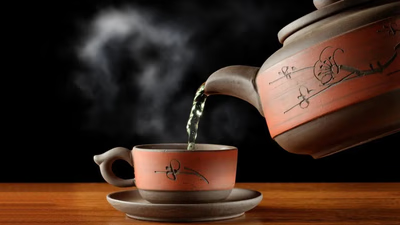
Diverse tea and coffee varieties reflect Middle Eastern culture.
The market for tea, coffee and other hot drinks is very strong in West Asia and these drinks form an important part of the culture and daily life of people in this region. The consumption of tea and coffee in these areas dates back to more than several centuries and is traditionally and formally used in ceremonies, social meetings and parties. Tea and coffee have a special taste that can attract the taste of many people. Tea with bitter and mild taste and coffee with bitter and strong taste are considered and some people enjoy this variety of taste.
Media and advertising have played an important role in increasing the popularity of tea and coffee in these regions. Advertisements and recommendations related to the benefits and properties of these drinks in the media and social networks have encouraged people to consume more of them. Tea and coffee in the Middle East and West Asia are available in different types and with different combinations. For example, in the case of tea, we can mention green tea, black tea, sour tea, and citrus tea. There are also different types of coffee, such as Arabic coffee, Turkish coffee, espresso coffee, etc. This variety and wide range of tea and coffee can give people the opportunity to make the right choice and increase popularity.
Green tea is one of the most popular types of tea in West Asia. This type of tea is prepared from fresh leaves of the tea plant and has properties such as antioxidant effects and energy increase. Black tea is also widely consumed in West Asia. This type of tea is prepared from the dried leaves of the tea plant and has a bitter and stronger taste than green tea. Sour tea is another popular drink in West Asia. This type of tea is prepared by adding lemon juice and sugar to black tea and has a bitter and sour taste.
Arabic coffee is one of the most popular types of coffee in West Asia. This type of coffee is prepared using crushed coffee beans and water and has a mild and aromatic taste. Turkish coffee is also welcomed in this region. This type of coffee is prepared using crushed coffee beans and water and is served stronger and with a thick base. Cow's milk is widely consumed in West Asia and is used hot or cold. Teas are also popular and are available in different types such as saffron, mint, ginger, etc.
The tea and coffee industry in West Asia is very rich and includes production, import, export and sale in the domestic market. In some West Asian countries such as Turkey, Iran, Saudi Arabia and Iraq, tea and coffee consumption is very common. In these countries, the ceremony of preparing and drinking tea and coffee is very important for many people, especially in social gatherings and homes. In Turkey, Turkish coffee is widely known and coffee drinking is an important social event. Turkish coffee is usually served in small cans and can be sweet or bitter. Also, black tea is commonly consumed in Turkey and is served hot.
In Iran, green tea is considered as a popular drink and is widely consumed at all hours of the day. In Iran, tea is served hot and sweet and is usually eaten with sweets and tarabaran. Coffee is also consumed in Iran, but it is less popular than tea. In Saudi Arabia and other Arab countries, Arabic coffee is very popular. Arabic coffee is served strong without sugar and is usually consumed in formal meetings and homes. Also, green tea is traditionally consumed in Saudi Arabia. In Iraq, tea and coffee are both commonly consumed. Tea in Iraq is served warm and sweet, and coffee is consumed strong and without sugar.
In the Middle East and West Asia, tea and coffee are considered as cultural and artistic elements. For example, in some countries of the Middle East, serving tea with special designs and using special accessories is considered artistic and beautiful. Also, in some countries, there are special rituals for preparing and serving coffee, which are considered as a branch of art and local culture. This influence of culture and art can contribute to the popularity of tea and coffee in these regions.
Tea and coffee in these regions have a very long history and are known as part of the culture and daily life of people in these regions. Tea and coffee have properties and positive effects on health and this can be one of the reasons for their popularity in these regions. Some of these effects include increased energy, strengthening the immune system, reducing the risk of cardiovascular disease, and antioxidant effects. Drinking tea and coffee in the Middle East and West Asia is a social and recreational activity. People in these areas often drink tea and coffee with their family, friends and colleagues and this contributes to their popularity.
-

Digital marketing strategies are essential for attracting new customers in the tea and coffee sector within West Asia. Establishing a strong online presence through websites, social media, and email marketing can enhance visibility and engagement. Creating compelling content that highlights the quality and origin of products is crucial for differentiation. Offering incentives such as free samples and discounts can encourage trial among potential customers. Collaborating with local businesses like cafes and restaurants can expand reach, while market research helps tailor strategies to meet customer needs effectively. Understanding local regulations and import laws is vital for successful market entry. Building strong partnerships with reliable local businesses aids in navigating export challenges, including logistics and compliance with health standards. Utilizing technology, such as e-commerce platforms and digital communication tools, streamlines operations and enhances customer interaction.
Continuous education on industry trends and regulations ensures adaptability in a competitive landscape. By implementing these strategies, businesses can successfully penetrate new markets and foster long-term customer relationships.
-

International trade in tea and coffee faces numerous challenges, primarily due to intense competition among manufacturers and exporters. Companies must differentiate themselves to attract customers while navigating complex legal and commercial issues, including varying import/export regulations, tariffs, and health standards. Each country has unique requirements that affect compliance, impacting market entry strategies. Additionally, cultural differences necessitate tailored marketing approaches to resonate with local consumers. Factors such as climate change, resource limitations, and fluctuating prices further complicate the landscape. Effective pricing strategies and risk management are essential for maintaining competitiveness. Financial hurdles like payment processing and currency exchange also pose significant challenges for exporters. Moreover, ensuring quality during international transportation requires careful planning of logistics and supply chain management.
Understanding local customs and languages is crucial for successful communication with target markets. Overall, businesses must be well-informed about regional market insights to navigate these complexities effectively.
-

Tea and coffee are among the most consumed beverages globally, with varying consumption patterns across regions. Tea is particularly popular in Asia and Europe, with countries like Turkey, Iran, China, India, Russia, and Pakistan leading in consumption. Coffee enjoys high popularity in Brazil, the United States, Germany, France, Italy, and Turkey. Each region has its unique varieties influenced by cultural practices and consumer preferences. The tea market is characterized by types such as green and white tea known for their health benefits. Conversely, coffee varieties include Arabica and Robusta, each with distinct flavors. The dynamic nature of the tea and coffee market is shaped by factors like production levels, import/export regulations, consumer tastes, cultural significance, pricing fluctuations, technological advancements, competition, and marketing strategies. Recent growth in these industries can be attributed to rising health awareness among consumers and innovations in product offerings.
Countries such as China and India dominate tea production while Brazil and Vietnam lead in coffee exports. This diversity enhances the significance of tea and coffee within international trade frameworks.
-

The tea and coffee market in West Asia is deeply rooted in cultural practices, with consumption dating back centuries. These beverages play a significant role in social gatherings, ceremonies, and daily life. The variety of teas, including green, black, and sour tea, along with different coffee types such as Arabic and Turkish coffee, cater to diverse tastes. Media advertising has significantly boosted their popularity by highlighting health benefits and unique flavors. Countries like Turkey, Iran, Saudi Arabia, and Iraq showcase distinct drinking customs; for instance, Turkish coffee is served strong and sweetened or unsweetened during social events. In Iran, green tea is favored throughout the day while Arabic coffee is a staple in formal settings in Saudi Arabia. The cultural significance of these drinks extends to artistic presentation and preparation rituals that enhance their appeal. Health benefits associated with tea and coffee consumption include increased energy levels and improved immune function. Overall, the rich history and cultural importance of tea and coffee contribute to their enduring popularity in the Middle East.




